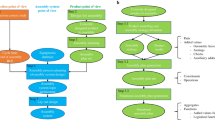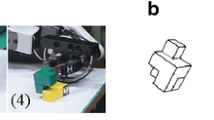Computer-aided process planning forms a vital link in the realization of a completely automated manufacturing environment. This paper addresses issues related to automatically generating assembly sequences from the geometric description of part components. Determination of assembly sequence depends on physical characteristics of the components, and their relative position in the final assembly, in order to accomplish functional goals of the assembly. A knowledge-based architecture for extracting and representing explicit interface information between part components, with minimal expert interaction, is presented in this paper. The concept of articulation points is used to decompose the complete assembly into constituent subassemblies. Finally, a feasible sequence is generated for each subassembly.
Similar content being viewed by others
References
Aho, A., Hopcroft, J. and Ullman, J. (1974) The Design and Analysis of Computer Algorithms, Addison-Wesley, Reading, MA.
Ambler, A. P. and Popplestone, R. J. (1975) Inferring the positions of bodies from specified spacial relationships. Artificial Intelligence, 6, 157–174.
Boneschanscher, N. and Heemskerk, C. J. M. (1990) Grouping parts to reduce the complexity of assembly sequence. In Information Control Problems in Manufacturing Technology 1989: Selected Papers from the 6th IFAC/IFIP/IFORS/IMACS Symposium, Madrid, Spain, IFAC, pp. 233–238.
Boothroyd, G. and Dewhurst, P. (1983) Design for Assembly: A Designer's Handbook, University of Massachusetts, Dept. of Mechanical Engineering.
Bourjault, A. (1984) Contribution à une approche méthodologique de l'assemblage automatisé: Elaboration automatique des séquences opératiores, PhD Thesis, L'Université de Franche Comté.
De Fazio, T. and Whitney, D. (1987) Simplified generation of all mechanical assembly sequences. IEEE Journal of Robotics and Automation, 3(6), 640–658.
De Fazio, T. and Whitney, D. (1988) Correction to - Simplified generation of all mechanical assembly sequences. IEEE Journal of Robotics and Automation, 4(6), 705–708.
De Floriani, L. and Nagy, G. (1989) A graph model of face-to-face assembly in Proceedings of IEEE International Conference on Robotics and Automation, 1, pp. 75–78.
Delchambre, A. (1990) Data structures for computer-aided assembly planning: a survey, in Information Control Problems in Manufacturing Technology 1989: Selected Papers from the 6th IFAC/IFIP/IFORS/IMACS Symposium, Madrid, Spain, IFAC, pp. 419–424.
Eastman, C. M. (1981) The design of assemblies, Technical Report 810197, Society of Automotive Engineers, Inc.
Grossman, D. D. (1976). Procedural representation of three-dimensional objects. IBM Journal of Research and Development, 20, 582–589.
Homem de Mello, L. and Sanderson, A. (1986). AND/OR graph representation for assembly plans in Proceedings of AAAI Conference, pp. 1113–1119.
Homem de Mello, L. and Sanderson, A. (1989) A correct and complete algorithm for the generation of mechanical assembly sequences, in Proceedings of IEEE International Conference on Robotics and Automation, 1, pp. 56–61.
Huang, Y. and Lee, C. (1988) Precedence knowledge in feature mating operation assembly planning, Engineering Research Center for Intelligent Manufacturing Systems Report ERC- 22, Purdue University, West Lafayette.
Kim, M. and Wu, C.-H. (1990) A formal part mating model for generating compliance control strategies of assembly operations, in Proceedings of 1990 IEEE International Conference on Systems, Man, and Cybernetics, IEEE, Los Angeles, CA, pp. 611–616.
Ko, H. and Lee, K. (1987) Automatic assembling procedure generation from mating conditions. Computer-Aided Design, 19(1), 3–10.
Kroll, E., Lenz, E. and Wolberg, J. (1989) Generation of exploded views and assembly sequences. Artificial Intelligence in Engineering Design, Analysis, and Manufacturing, 3(3), 143–155.
Lee, K. and Andrews, G. (1985) Inference of the positions of components in an assembly: part 2. Computer-Aided Design, 17(1), 20–24.
Lee, K. and Gossard, D. C. (1985) A hierarchical data structure for representing assemblies: part 1. Computer- Aided Design, 17(1), 15–19.
Lee, S. and Shin, Y. G. (1988) Automatic construction of assembly partial-order graphs, in Proceedings of the International Conference on Computer Integrated Manufacturing, IEEE, Tsoy, NA, pp. 383–392.
Lin, A. C. (1990) Automated assembly planning for three dimensional mechanical products, PhD Thesis, Purdue University, West Lafayette.
Liu, Y. and Popplestone, R. (1989) Planning for assembly from solid models, in Proceedings of IEEE International Conference on Robotics and Automation, 1, pp. 222–227.
Mattikalli, R. S., Khosla, P. K. and Xu, Y. (1990) Subassembly identification and motion generation for assembly: a geometric approach, in Proceedings of IEEE International Conference on Systems Engineering, IEEE, Pittsburgh, PA, pp. 399–403.
Popplestone, R. J., Ambler, A. and Bellos, I. (1978) RAPT: a language for describing assemblies. Industrial Robot, 5(3), 131–137.
Popplestone, R. J., Ambler, A. P. and Bellos, I. M. (1980) An interpreter for a language for describing assemblies. Artificial Intelligence, 14, 79–107.
Roy, U., Banerjee, P. and Liu, C. (1989) Design of an automated assembly environment. Computer-Aided Design, 21, 561–569.
Roy, U. and Liu, C. (1988) Establishment of functional relationships between product components in assembly database. Computer-Aided Design, 20(10), 570–580.
Sekiguchi, H., Kojima, T. and Inoue, K. (1983) Study on automatic determination of assembly sequence. Annals of CIRP, 32, 371–374.
Thomas, F. and Torras, C. (1988) A group theoretic approach to computation of symbolic part relations. IEEE Journal of Robotics and Automation, 4(6), 622–634.
Vijaykumar, R. and Arbib, M. A. (1987) Problem decomposition for assembly planning, in Proceedings of IEEE International Conference on Robotics and Automation, pp. 1363–1366.
Wesley, M. A., Lozano-Perez, T., Lieberman, L. I., Lavin, M. A. and Grossman, D. D. (1980) A geometric modeling system for automated mechanical assembly. IBM Journal of Research and Development, 24(1), 64–74.
Wolter, J. (1989) On the automatic generation of assembly plans in Proceedings of IEEE International Conference on Robotics and Automation, 1, pp. 62–68.
Woo, T. C. (1987) Automatic disassembly and total ordering in three dimensions, Department of Industrial and Operations Engineering Report 87-9, University of Michigan.
Author information
Authors and Affiliations
Rights and permissions
About this article
Cite this article
Deshmukh, A., Paul Yung, J. & Wang, HP.(. Automated generation of assembly sequence based on geometric and functional reasoning. J Intell Manuf 4, 269–284 (1993). https://doi.org/10.1007/BF00124140
Issue Date:
DOI: https://doi.org/10.1007/BF00124140




